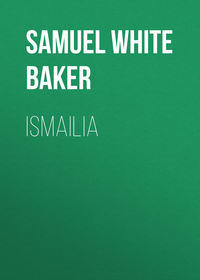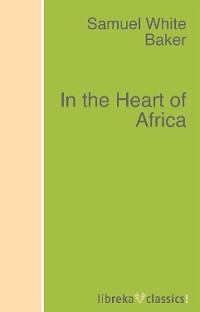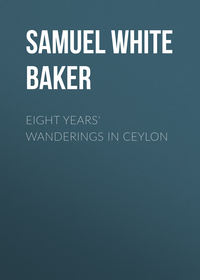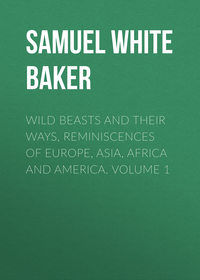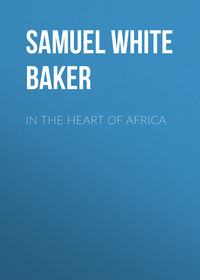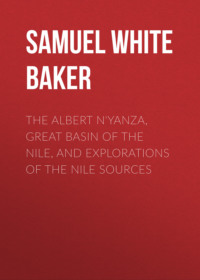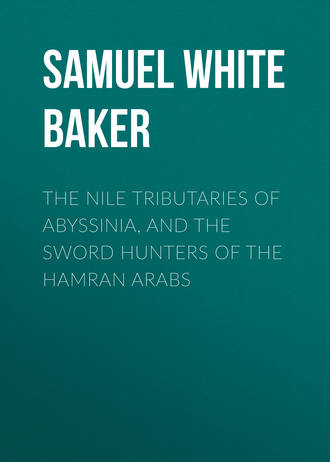 полная версия
полная версияThe Nile Tributaries of Abyssinia, and the Sword Hunters of the Hamran Arabs
On my return to camp I visited the establishments of the various slave merchants: these were arranged under large tents formed of matting, and contained many young girls of extreme beauty, ranging from nine to seventeen years of age. These lovely captives, of a rich brown tint, with delicately-formed features, and eyes like those of the gazelle, were natives of the Galla, on the borders of Abyssinia, from which country they were brought by the Abyssinian traders to be sold for the Turkish harems. Although beautiful, these girls are useless for hard labour; they quickly fade away and die unless kindly treated. They are the Venuses of that country, and not only are their faces and figures perfection, but they become extremely attached to those who show them kindness, and they make good and faithful wives. There is something peculiarly captivating in the natural grace and softness of these young beauties, whose hearts quickly respond to those warmer feelings of love that are seldom known among the sterner and coarser tribes. Their forms are peculiarly elegant and graceful—the hands and feet are exquisitely delicate; the nose is generally slightly aquiline, the nostrils large and finely shaped; the hair is black and glossy, reaching to about the middle of the back, but rather coarse in texture. These girls, although natives of Galla, invariably call themselves Abyssinians, and are generally known under that denomination. They are exceedingly proud and high-spirited, and are remarkably quick at learning. At Khartoum, several of the Europeans of high standing have married these charming ladies, who have invariably rewarded their husbands by great affection and devotion. The price of one of these beauties of nature at Gallabat was from twenty-five to forty dollars.
On the 24th April we were refreshed by a shower of rain, and in a few days the grass sprang from the ground several inches high. There was an unpleasant dampness in the air, and, although the rainy season would not commence until June, showers would occasionally fall among the mountains throughout the month of May. I accordingly purchased a number of large tanned ox-hides, that are rendered waterproof by a preparation with milk. These skins cost the trifling sum of nine piastres each (not two shillings), and were subsequently of great value during our White Nile expedition, as coverlets during the night's bivouac, &c.
The horse-fair was a disappointment. At this season the entire country in the neighbourhood of Gallabat was subject to an epidemic, fatal to these animals; therefore there were no good horses present. I had nothing to detain me at this place, after having procured fresh camels, therefore I paid all my people, and we parted excellent friends. To the Arabs and Tokrooris I gave all the hides of rhinoceros, elephants, &c. that I did not require, and, with our loads considerably lightened, we started from Gallabat, 12.30 P.M., 28th April, 1862, and marched due west towards the river Rahad. The country was hilly and wooded, the rocks were generally sandstone, and after a march of three hours we halted at a Tokroori village. I never witnessed more unprovoked insolence than was exhibited by these people. They considered me to be a Turk, to whom their natural hatred had been increased by the chastisement they had lately received from the Egyptians. It was in vain that my two lads, Wat Gamma and Bacheet, assured them that I was an Englishman: they had never heard of such a country as England; in their opinion, a white man must be a Turk. Not contented with refusing all supplies, they assembled in large numbers and commenced a quarrel with my men, several of whom were Tokrooris that I had hired to accompany us to Khartoum. These men, being newly engaged and entirely strange, were of little service; but, having joined in the quarrel like true Tokrooris, who are always ready for a row, the altercation grew so hot that it became rather serious. The natives determined that we should not remain in their village, and, having expressed a threat to turn us out, they assembled around us in a large crowd with their lances and trombashes. My wife was sitting by me upon an angarep, when the people closed around my men, and one very tall specimen of a Tokroori came forward, and, snatching a knife from its sheath that was worn upon the arm of my servant, he challenged him to fight. As Tokrooris are always more or less under the influence of drink, their fights are generally the effect of some sudden impulse. It was necessary to do something, as the crowd were determined upon a row; this was now commenced by their leader, who was eyeing me from head to foot with the most determined insolence, holding the knife in his hand that he had taken from my man. I therefore rose quietly from my seat, and, approaching him to within a convenient distance for striking, if necessary, I begged him very politely to leave my people to themselves, as we should depart on the following morning. He replied with great impertinence, and insisted upon fighting one or all of our party. I accommodated him without a moment's delay, as, stepping half a pace backwards, I came in with a left and right as fast as a rapid double-hit could be delivered, with both blows upon his impudent mouth. In an instant he was on his back, with his heels in the air; and, as I prepared to operate upon his backer, or upon any bystander who might have a penchant for fighting, the crowd gave way, and immediately devoted themselves to their companion, who lay upon the ground in stupid astonishment, with his fingers down his throat searching for a tooth; his eyes were fixed upon my hands to discover the weapon with which he had been wounded. His friends began to wipe the blood from his face and clothes, and at this juncture the sheik of the village appeared for the first time.
To my astonishment he was extremely civil; a sudden reaction had taken place, the Tokrooris had had their row, and were apparently satisfied. The sheik begged me not to kill his people by hitting them, "as they were mere chickens, who would at once die if I were to strike them with my fist." I begged him to keep his "chickens" in better order, and at once to order them away from our immediate neighbourhood. In a few minutes the sheik drove the crowd away, who picked up their man and led him off. The sheik then begged us to accept a hut for the night, and he paid us every attention.
On the following morning, we left shortly after sunrise; the natives very civilly assisted to load our camels, and among the most active was my fighting friend of yesterday, who, with his nose and mouth all swollen into one, had been rapidly converted from a well-featured Tokroori into a real thick-lipped, flat-nosed African nigger, with prognathous jaw, that would have delighted the Ethnological Society.
"April 29.—It rained hard during the night. Our course was due west, along the banks of a hor, from which the natives procure water by sinking wells about twelve feet deep in the sandy bed, which is dry in the hot season. Throughout this country the water is bad. At 11 A.M. we reached Roumele; this is the last village between Gallabat and the river Rahad. The natives say that there is no water on the road, and their accounts of the distance are so vague and contradictory that I cannot rely upon the information.
"I could procure only one water-skin, and none of my old stock were serviceable; I therefore arranged to water all the animals, and push on throughout the night, by which plan I hoped to arrive by a forced march at the Rahad on the following morning, without exhausting both men and beasts by a long journey through an unknown distance in the heat of the sun. Hardly were the horses watered at a well in the dry bed of the stream, when Aggahr was taken ill with inflammation. I left two men to attend upon him, with orders to bring him on if better on the following day: we started on our journey, but we had not proceeded a quarter of a mile when Gazelle, that I was riding, was also seized with illness, and fell down; with the greatest difficulty I led the horse back again to the village. My good old hunter Aggahr died in great agony a few minutes after our return, and Gazelle died during the night; the natives declared this to be the horse sickness that was annually prevalent at this season. The disease appeared to be inflammation of the bowels, which I attributed to the sudden change of food; for months past they had lived principally upon dry grass, but within the past few days they had greedily eaten the young herbage that had appeared after a few showers; with this, may have been poisonous plants that they had swallowed unawares. We had now only one horse, Tetel, that was ridden by my wife; I therefore determined to start on foot on the following morning, and to set the pace at four miles an hour, so as to reach the Rahad by a forced march in one rapid stretch, and thus to eke out our scanty supply of water. Accordingly we started, and marched at that rate for ten hours, including a halt when half-way, to rest for one hour and a half. Throughout the distance, the country was a dead flat of the usual rich soil, covered with mimosa forest. We marched thirty-four miles, steering due west for a distant hill, which in the morning had been a faint blue streak upon the horizon.
"Upon our arrival at the hill, we found that the river was some miles beyond, while a fine rugged mountain that we had seen for two days previous rose about fifteen miles south of this point, and formed an unmistakeable landmark; the name of this mountain is Hallowa. We had marched with such rapidity across this stretch of thirty-four miles, that our men were completely exhausted from thirst, as they had foolishly drunk their share of water at the middle of the journey, instead of reserving it for the moment of distress. Upon arrival at the Rahad they rushed down the steep bank, and plunged into the clear water of the river.
"The Rahad does not exceed eighty or ninety yards in breadth. The rain that had recently fallen in the mountain had sent a considerable stream down the hitherto dry bed, although the bottom was not entirely covered. By dead reckoning, this point of the river is fifty-five miles due west from Gallabat or Metemma; throughout this distance we had seen no game, neither the tracks of any animals except giraffes. We were rather hard up for provisions, therefore I took my rod, and tried for a fish in a deep pool below the spot where we had pitched the tent. I only had one run, but I fortunately landed a handsome little baggar about twelve pounds weight, which afforded us a good dinner. The river Dinder is between fifty and sixty miles from the Rahad at this point, but towards the north the two rivers approximate closely, and keep a course almost parallel. The banks of the Rahad are in many places perpendicular, and are about forty-five feet above the bed. This river flows through rich alluvial soil; the country is a vast level plane, with so trifling a fall that the current of the river is gentle; the course is extremely circuitous, and although, when bank full, the Rahad possesses a considerable volume, it is very inferior as a Nile tributary to any river that I have visited to the east of Gallabat."
CHAPTER XXI
FERTILITY OF THE COUNTRY ON THE BANKS OF THE RAHAD
WE daily followed the banks of the Rahad, the monotony of which I will not inflict upon the public. This country was a vast tract of wonderfully fertile prairie, that nearly formed an island, surrounded by the Rahad, Blue Nile, Great Nile, and Atbara; it was peopled by various tribes of Arabs, who cultivated a considerable extent upon the banks of the Rahad, which for upwards of a hundred miles to the north were bordered with villages at short intervals. Cotton and tobacco were produced largely, and we daily met droves of camels laden with these goods, en route for the Abyssinian market. We had now fairly quitted Abyssinian territory, and upon our arrival at the Rahad we were upon the soil of Upper Egypt. I was much struck with the extraordinary size and condition of the cattle. Corn (dhurra) was so plentiful that it was to be purchased in any quantity for eight piastres the rachel, or about 1s. 8d. for 500 pounds; pumpkins were in great quantities, with a description of gourd with an exceedingly strong shell, which is grown especially for bowls and other utensils; camel-loads of these gourd-basins packed in conical crates were also journeying on the road towards Gallabat. Throughout the course of the Rahad the banks are high, and, when full, the river would average forty feet in depth, with a gentle stream, the course free from rocks and shoals, and admirably adapted for small steamers.
The entire country would be a mine of wealth were it planted with cotton, which could be transported by camels to Katariff, and thence direct to Souakim. We travelled for upwards of a hundred miles along the river, through the unvarying scene of flat alluvial soil; the south bank was generally covered with low jungle. The Arabs were always civil, and formed a marked contrast to the Tokrooris; they were mostly of the Roofar tribe. Although there had been a considerable volume of water in the river at the point where we had first met it, the bed was perfectly dry about fifty miles farther north, proving the great power of absorption by the sand. The Arabs obtained water from deep pools in the river, similar to those in the Atbara, but on a small scale, of not sufficient importance to contain hippopotami, which at this season retired to the river Dinder. Wherever we slept we were besieged by gaping crowds of Arabs: these people were quite unaccustomed to strangers, as the route we had chosen along the banks of the Rahad was entirely out of the line adopted by the native merchants and traders of Khartoum, who travelled via Abou Harraz and Katariff to Gallabat. These Arabs were, as usual, perfectly wild, and ignorant of everything that did not immediately concern them. My compass had always been a source of wonder to the natives, and I was asked whether by looking into it I rould distinguish the "market days" of the different villages. My own Tokrooris continually referred to me for information on various topics, and, if I declined to reply, they invariably begged me to examine my moondera (mirror), as they termed the compass, and see what it would say. This country swarmed with Arabs, and abounded in supplies: superb fat oxen were seven dollars each; large fowls were a penny; and eggs were at the rate of nine for a penny farthing.
We arrived at a large village, Sherrem, on May 11, having marched 118 miles in a straight line along the course of the Rahad. The heat was extreme, but I had become so thoroughly accustomed to the sun that I did not feel it so much as my men, whose heads were covered with a thin cap of cotton (the tageea). My camel-men had expected to find their families at a village that we had passed about six miles from Sherrem, and they had been rejoicing in anticipation, but on arrival we found it deserted,—"family out of town;" the men were quite dejected; but upon arrival at Sherrem they found all their people, who had migrated for water, as the river was dry. We waited at Sherrem for a couple of days to rest the men, whose feet were much swollen with marching on the burning soil. Although frequent showers had fallen at Gallabat, we had quickly entered the dry country upon steering north, where neither dew nor rain had moistened the ground for many months. The country was treeless on the north bank of the Rahad, and the rich alluvial soil was free from a single stone or pebble for many miles. Although for 118 miles we had travelled along the course of the Rahad, throughout this distance only one small brook furrowed the level surface and added its waters during the rainy season to the river; the earth absorbed the entire rainfall. Our camels were nearly driven mad by the flies which swarmed throughout the fertile districts.
On the 15th of May we arrived at Kook, a small village on the banks of the Rahad, and on the following morning we started to the west for the river Dinder. The country was the usual rich soil, but covered with high grass and bush; it was uninhabited, except by wandering Arabs and their flocks, that migrate at the commencement of the rainy season, when this land becomes a mere swamp, and swarms with the seroot fly. At 6.30 we halted, and slept on the road. This was the main route to Sennaar, from which place strings of camels were passing to the Rahad, to purchase corn. On the 16th of May, we started by moonlight at 4.30 A.M. due west, and at 7.30 A.M. we arrived at the river Dinder, which, at this point, was eighteen miles from the village of Kook, on the Rahad.
We joined a camp of the Kunana Arabs, who at this season throng the banks of the Dinder. This river is similar in character to the Rahad, but larger: the average breadth is about a hundred and ten yards: the banks are about fifty feet high, and the immediate vicinity is covered with thick jungle of nabbuk and thorny acacias, with a great quantity of the Acacia Arabica, that produces the garra, already described as valuable for tanning leather. I made ink with this fruit, pounded and boiled, to which I added a few rusty nails, and allowed it to stand for about twenty-four hours. The Dinder was exceedingly deep in many places, although in others the bed was dry, with the exception of a most trifling stream that flowed through a narrow channel in the sand, about an inch in depth. The Arabs assured me that the crocodiles in this river were more dangerous than in any other, and their flocks of goats and sheep were attended by a great number of boys, to prevent the animals from descending to the water to drink, except in such places as had been prepared for them by digging small holes in the sand. I saw many of these creatures, of very large size; and, as I strolled along the banks of the river, I found a herd of hippopotami, of which I shot two, to the great delight of my people, who had been much disappointed at the absence of game throughout our journey from Gallabat. We had travelled upwards of 200 miles without having seen so much as a gazelle, neither had we passed any tracks of large game, except, upon one occasion, those of a few giraffes. I had been told that the Dinder country was rich in game, but, at this season, it was swarming with Arabs, and was so much disturbed that everything had left the country, and the elephants merely drank during the night, and retreated to distant and impenetrable jungles. At night we heard a lion roar, but this, instead of being our constant nightingale, as upon the Settite river, was now an uncommon sound. The maneless lion is found on the banks of the Dinder; all that I saw, in the shape of game, in the neighbourhood of that river and the Rahad, were a few hippopotami and crocodiles. The stream of the Dinder is obstructed with many snags and trunks of fallen trees that would be serious obstacles to rapid navigation: these are the large stems of the soont (Acacia Arabica), that, growing close to the edge, have fallen into the river when the banks have given way. I was astonished at the absence of elephants in such favourable ground; for some miles I walked along the margin of the river without seeing a track of any date. Throughout this country, these animals are so continually hunted that they have become exceedingly wary, and there can be little doubt that their numbers are much reduced. Even in the beautiful shooting country comprised between the river Gash and Gallabat, although we had excellent sport, I had been disappointed at the number of elephants, which I had expected to find in herds of many hundreds, instead of forty or fifty, which was the largest number that I had seen together. The habits of all animals generally depend upon the nature of the localities they inhabit. Thus, as these countries were subject to long drought and scarcity of water, the elephants were, in some places, contented with drinking every alternate day. Where they were much hunted by the aggageers, they would seldom drink twice consecutively in the same river; but, after a long draught in the Settite, they would march from twenty-five to thirty miles, and remain for a day between that river and the Mareb or Gash, to which they would hurry on the following night. At other times, these wily animals would drink in the Settite, and retire to the south; feeding upon Mek Nimmur's corn-fields, they would hurry forward to the river Salaam, about thirty miles distant, and from thence, in a similar manner, either to the Atbara on one side, or into the Abyssinian mountains, where, at all times, they could procure a supply of water. I have frequently discovered fresh grains of dhurra in their dung, at a great distance from the nearest corn-field; when the rapid digestion of the elephant is considered, it must be allowed that the fresh dung found in the morning bore witness to the theft of corn during the past night; thus the elephant had marched many miles after feeding. In the "Rifle and Hound in Ceylon," published in 1854, I gave a detailed description of the elephants of that country, which, although peculiar in the general absence of tusks, are the same as the Indian species.
Although the elephant is found throughout many countries, extending over an enormous area, there are only two species at present in existence,—the Indian and African; these are totally different in their habits, and are distinguished by peculiarities of form. The most striking difference is in the shape of the head and spine. The head of the Indian species is perfectly distinct; the forehead, when held in the natural position of inaction, is perpendicular; and above the slight convexity at the root of the trunk there is a depression, in shape like a herald's shield: a bullet in the lower portion of that shield would reach the brain in a direct line. The head of the African elephant is completely convex from the commencement of the trunk to the back of the skull, and the brain is situated much lower than in that of the Indian species; the bone is of a denser quality, and the cases for the reception of the tusks are so closely parallel, that there is barely room for a bullet to find a chance of penetrating to the brain; it must be delivered in the exact centre, and extremely low, in the very root of the trunk; even then it will frequently pass above the brain, as the animal generally carries his head high, and thrown slightly back. The teeth of the African elephant differ materially from those of the Indian, by containing a lesser number of laminae or plates, the surfaces of which, instead of exhibiting straight and parallel lines like those of the Indian, are shaped in slight curves, which increase the power of grinding. The ears of the African species are enormous, and when thrown back they completely cover the shoulders; they are also entirely different in shape from those of the Indian species. When an African bull elephant advances in full charge with his ears cocked, his head measures about fourteen feet from the tip of one ear to that of the other, in a direct line across the forehead. I have frequently cut off the ear to form a mat, upon which I have slept beneath the shade of a tree, while my people divided the animal.
The back of the Indian elephant is exceedingly convex; that of the African is exactly the reverse, and the concavity behind the shoulders is succeeded by a peculiarity in the sudden rise of the spine above the hips. The two species are not only distinct in certain peculiarities of form, but they differ in their habits. The Indian elephant dislikes the sun, and invariably retreats to thick shady forests at sunrise; but I have constantly found the African species enjoying themselves in the burning sun in the hottest hours of the day, among plains of withered grass, many miles from a jungle. The African is more active than the Indian, and not only is faster in his movements, but is more capable of enduring long marches, as proved by the great distances through which it travels to seek its food in the native's corn-fields. In all countries, the bulls are fiercer than the females. I cannot see much difference in character between the Indian and the African species; it is the fashion for some people to assert that the elephant is an innocent and harmless creature, that, like the giraffe it is almost a sin to destroy. I can only say that, during eight years' experience in Ceylon, and nearly five years' in Africa, I have found that elephants are the most formidable animals with which a sportsman has to contend. The African species is far more dangerous than the Indian, as the forehead shot can never be trusted; therefore the hunter must await the charge with a conviction that his bullet will fail to kill.


